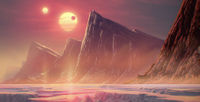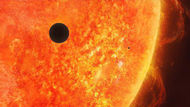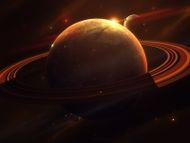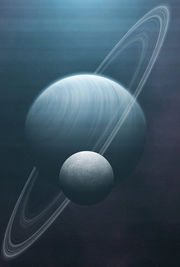
|
Under Construction This page seems to be Under Construction. Watch out for large groups of Rebel fighters.
After construction is complete, please remove this message.
|
Template:HOUWikiUpdate
The Kiast system is situated in the Nilgaard sector in the Outer Rim Territories. It is the home system of Clan Odan-Urr and the headquarters of the Jedi resistance against the Dark Council.
The Kiast system is located somewhere within the Palioxis Cloud nebula in an isolated part of the sector, away from prominent trade routes.
Binary star
 Kiast, from Kaerls
Kiast, from Kaerls
Kiast is a binary star system, containing two suns orbiting around each other. The smaller, Kiast Besh, orbits around its larger twin, Kiast Aurek. Aurek is a G-class star in its prime, glowing bright yellow and hot, providing Kiast and the outlying planets with plentiful warmth and energy for growth.
Besh is a B-class star, a red draw formed from leftover material that Aurek failed to pull in upon its creation. Orbiting at a fair distance from its twin, Besh is the star closest to Kiast, and while its heat is far less apparent than its twin’s, its gravitational pull has a very strong influence on Kiast’s tectonic activity. It has a very stable orbit, affecting the main planet only during the summer months, when it’s closest to it.
Orbits
Quelor
 Quelor orbits close to its star
Quelor orbits close to its star
- Distance from the Sun: 33 mil. km
- Diameter: 4,420 km
- Revolution period: 32 standard days
- Rotation period: 35 standard days
- Moons: Ka
- Atmosphere: None
- Temperature: Quelor’s surface temperatures range from 988 degrees to -270 degrees Standard.
- Composition: Rocky planet
Quelor is a dead rock formed too close to the binary star. It is constantly scorched by extreme temperatures, turning its surface into a desolate, hot and arid wasteland. The planet has a very thin meridian between the day and night sides where massive energies soar and temperature differentials wreak havoc on the environment, creating explosive geysers and volcanoes of frozen rock and ice.
Quelor’s rotation period is several days shorter than its revolution period, and the temperature conversion is slow and often very violent. However, despite the activity, Quelor has absolutely no atmosphere and only minimal gravity. Its one solitary moon is no better off as its revolutionary period around Quelor brings it near the binary star’s corona, annihilating anything and everything on its surface. Ka is, in essence, a very large crystallized rock formed from billions of years of extreme temperatures from its parent star.
Sorilis
 Sorilis, the giant
Sorilis, the giant
- Distance from the Sun: 120 mil. km
- Diameter: 42,412 km
- Revolution period: 212 Standard Days
- Rotation period: 32 Standard Hours
- Moons:
- Atmosphere: Type IV
- Temperature: -55˚C to -115˚C
- Composition: Gas Giant
Sorilis is a gas giant composed of hydrogen with a quarter of its mass being helium, though helium comprises only about a tenth of the number of molecules. It may also have a rocky core of heavier elements, but like the other giant planets, Sorilis lacks a well-defined solid surface. Clouds of ammonia crystals perpetually cover its surface, arranged into bands of different latitudes known as tropical regions. The interactions of these bands and zones create turbulence and storms. Thin clouds of water underlying the ammonia layer are known to cause lightning storms in the atmosphere of Sorilis.
Kiast
 Kiast, the Capital
Kiast, the Capital
- Distance from the Sun: 88 mil. km
- Diameter: 14.432 km
- Revolution period: 426 Standard Days
- Rotation period: 24.2 Standard Hours
- Moons:
- Hoth moon (???)
- Shan moon (???)
- Ice moon (???)
- Atmosphere: Type I/Type IV
- Temperature: 205˚C(surface level) to 25˚C
- Composition: Terrestrial
Main Article: Kiast (Planet)
Kiast is a terrestrial world uniquely formed to hold both type I and type IV atmospheres. Its surface is covered in a thick concoction of toxic gases heavier than air which makes its surface uninhabitable to most of the galactic species. Above the cloud cover, however, life blooms in large hovering cities and space stations, starships and airships. It is the home of Clan Odan-Urr and their base of operations to fight the Sith menace and the Dark Brotherhood.
Kiast is the Capital of the Vatali Empire and their main source of tibanna gas exports. The Vatali colonized Kiast several hundred years before the Galactic Empire and severed ties with their home system to create a sovereign system.
Kaerls ice moon
 Kaerls, the unforgiving
Kaerls, the unforgiving
- Diameter: ~6.000 km
- Revolution period: ???
- Rotation period: ???
- Atmosphere: Type I
- Temperature: ???
- Composition: Terrestrial
The Kaerls ice moon is one of the worlds orbiting Kiast. It is the farthest away from its homeworld and has a fairly low revolutionary period, keeping in the dark side of the planet for most of the year. As such the moon has formed a world-spanning winter that freezes completely during the winter months, while thawing only around the equator during the summer, revealing only a very thin belt of irrigable land.
The world has no sentient inhabitants, save for the colony inhabited by the Okami Mandalorians who govern the world in the name of the Vatali Empress. The Mandalorians govern and protect the vast ice mining diggers that collect, refine and transport drinkable water off-world to the rest of the Empire.
Unknown Planet 1
- Distance from the Sun: ???
- Diameter: ???
- Revolution period: ???
- Rotation period: ???
- Moons:
- ????
- Atmosphere: ???
- Temperature: ???
- Composition: ???
Unknown Planet 2
- Distance from the Sun: ???
- Diameter: ???
- Revolution period: ???
- Rotation period: ???
- Moons:
- ????
- Atmosphere: ???
- Temperature: ???
- Composition: ???